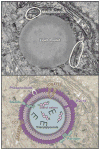Lipid droplets finally get a little R-E-S-P-E-C-T
- PMID: 19945371
- PMCID: PMC3097139
- DOI: 10.1016/j.cell.2009.11.005
Lipid droplets finally get a little R-E-S-P-E-C-T
Abstract
Long underappreciated as important cellular organelles, lipid droplets are finally being recognized as dynamic structures with a complex and interesting biology. In light of this newfound respect, we discuss emerging views on lipid droplet biology and speculate on the major advances to come.
Figures

References
-
- Altmann R. Die Elementarorganisem und ihre Beziehungen zu den Zellen. Leipzig: Veit; 1890.
-
- Blanchette-Mackie EJ, Dwyer NK, Barber T, Coxey RA, Takeda T, Rondinone CM, Theodorakis JL, Greenberg AS, Londos C. J Lipid Res. 1995;36:1211–1226. - PubMed
-
- Boström P, Andersson L, Rutberg M, Perman J, Lidberg U, Johansson B, Fernandez-Rodriguez J, Ericson J, Nilsson T, Borén J, et al. Nat Cell Biol. 2007;9:1286–1293. - PubMed
-
- Boulant S, Montserret R, Hope R, Ratinier M, Targett-Adams P, Lavergne J, Penin F, McLauchlan J. J Biol Chem. 2006;281:22236–22247. - PubMed
Publication types
MeSH terms
Substances
Grants and funding
LinkOut - more resources
Full Text Sources
Other Literature Sources

